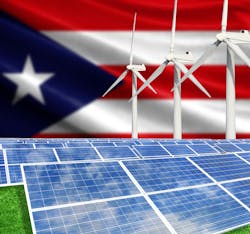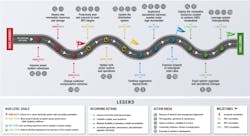Puerto Rico Can Achieve a 100% Renewable Energy Future and Microgrids Have a Role to Play
After a series of devastating hurricanes and an earthquake left its electric grid in shambles with transmission and distribution infrastructure destroyed, the Commonwealth of Puerto Rico made a decision that would completely overhaul the way it generates and delivers electricity.
With the 2019 passage of the Puerto Rico Energy Public Policy Act, also known as Act 17, the Puerto Rico Legislature set the U.S. territory on a path to meet 100% of its electricity needs with renewable energy by 2050.
The legislature set several milestones along the path to 2050, including achieving 40% renewables by 2025, phasing out coal-fired generation by 2028 and generating 60% of power needs with renewables by 2040.
This marks a significant shift away from a centralized approach to power, which is inefficient because the fossil fuels required to operate the grid have to be imported.
To help Puerto Rico identify pathways to reach these lofty goals, the U.S. Department of Energy (DOE), the Federal Emergency Management Agency (FEMA) and experts from six national laboratories launched a two-year study that included significant engagement with local stakeholders.
The results show there are three potential paths Puerto Rico can take to become 100% reliant on renewable energy over the next two and a half decades.
PR100 outlines pathways to clean energy success
Funded by FEMA and coordinated by the DOE, experts from the National Renewable Energy Laboratory, Oak Ridge National Laboratory, Lawrence Berkeley National Laboratory, Argonne National Laboratory, Sandia National Laboratories and Pacific Northwest National Laboratory launched the Puerto Rico Grid Resilience and Transitions to 100% Renewable Energy Study (PR100) in February 2022.
The researchers engaged with diverse groups of stakeholders to understand local priorities, such as the protection of agricultural land, and to ensure PR100 recommendations would be equitable for all populations.
In-depth data modeling and analysis revealed three scenarios for achieving clean energy success by 2050, dubbed the Economic, Equitable and Maximum scenarios.
Researchers defined the Economic scenario as “the economic adoption of distributed energy resources (DERs) based primarily on bill savings and value of backup power for building owners,” according to the report’s summary, while the Maximum scenario focused on optimizing the deployment of DERs on all suitable rooftops. The Equitable scenario expands the use of DERs to very low income and remote households.
The scenarios were further studied to understand their impact on Puerto Rico’s transmission system, as well as “the impacts to the distribution system and related considerations, such as microgrids,” the study summary said, noting that rooftop photovoltaic systems could be integrated into microgrids as a best practice.
Virtual power plants (VPPs) could also be used to support blue-sky operations, according to the researchers. VPPs use an intelligent control system and bidirectional technology to aggregate energy from networked resources located at multiple sites, such as solar plus storage systems and other DERs. The technology creates a reliable power network by bundling together what could be hundreds of discrete power sources into one that can be dispatched during times of peak demand, just as a centralized power plant would.
A road map for success
Researchers also created an implementation road map that outlines several immediate, near- and long-term actions that must be taken to stabilize the grid and improve resilience for Puerto Rico to reach its 2050 goal.
The top priority, according to the PR100 findings, is building a more robust electricity system and laying the foundation for significant renewable energy integration over the next two years. Specifically, the study calls for an increase in capacity, the deployment of new renewable energy and storage resources – including microgrids – and changes that incentivize stakeholder participation with renewable energy.
In the near term, Puerto Rico must take steps to update its bulk power and distribution systems, while in the long term, decision makers must be flexible as new technologies, such as long-duration energy storage, advance.
PR100 researchers also noted that “continually evaluating local resilience benefits, such as microgrids, will improve the resilience planning efforts across all time periods.”
Puerto Rico modeling a renewable grid
Puerto Rico has made significant headway in the adoption of renewables in recent years as businesses, homeowners and communities have taken steps to increase electric reliability, even in the face of natural disasters.
PR100 builds on those efforts, ultimately offering a model that other countries, including the U.S., can use to develop their own grid decarbonization plans.










